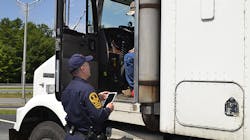CVSA schedules International Roadcheck for Sept. 9-11, focuses on driver requirements
On March 25, the Commercial Vehicle Safety Alliance (CVSA) postponed its 2020 International Roadcheck due to the growing novel coronavirus pandemic. CVSA has now rescheduled the 72-hour event for Sept. 9-11. This year’s enforcement initiative will focus on the driver requirements component of a roadside inspection.
Last month, CVSA conduced Operation Safe Driver Week, focusing on dangerous behaviors such as speeding, distracted driving, failure to use a seatbelt, following too closely, reckless driving, drunk or drugged driving, and more. CVSA continues its focus on the driver with this year's event.
According to CVSA, International Roadcheck is a three-day high-volume, high-visibility inspection when CVSA-certified inspectors in North America conduct commercial motor vehicle and driver inspections at weigh or inspection stations, at designated fixed locations or as part of roving mobile patrols. During that time, law enforcement officers will inspect commercial vehicles for compliance with federal regulations as well as use the North American Standard Out-of-Service Criteria to identify violations.
“Although the coronavirus pandemic, understandably, shifted priorities and personnel during the spring, the commercial motor vehicle law enforcement community has reasserted its focus on the roadside inspection program and enforcement duties,” said CVSA president John Samis.
During 2019's International Roadcheck, 3.36 million inspections were conducted and 952,938 driver violations were discovered, of which 199,722 were out-of-service conditions, according to the Federal Motor Carrier Safety Administration.
“Jurisdictions are nearly back to their pre-pandemic capacity with a strengthened concentration on identifying and removing unfit vehicles and drivers from our roadways using federal safety standards and the out-of-service criteria,” Samis added.
Driver inspection
For the driver portion of an inspection, the inspector will collect and verify the driver’s documents, identify the motor carrier, examine the driver’s license, check record of duty status and review periodic inspection reports, according to CVSA. If applicable, the inspector will check the Medical Examiner’s Certificate, Skill Performance Evaluation Certificate and the driver’s daily vehicle inspection report.
Inspectors will also check drivers for:
- Seat belt usage
- Illness
- Fatigue
- Apparent alcohol or drug possession or impairment
Drivers found to be operating without the proper driver credentials, in possession of or under the influence of drugs or alcohol, operating while ill, fatigued or showing other signs of impairment, or in violation of hours-of-service rules may be placed out of service.
Vehicle inspection
The vehicle portion of an inspection includes checking critical vehicle inspection items such as:
- Brake systems
- Cargo securement
- Coupling devices
- Driveline/driveshaft components
- Driver’s seat (missing)
- Exhaust systems,
- Frames
- Fuel systems
- Lighting devices
- Steering mechanisms
- Suspensions
- Tires
- Van and open-top trailer bodies
- Wheels, rims and hubs
- Windshield wipers
If an inspector discovers critical violations during an inspection, the vehicle will be rendered out of service, meaning that vehicle will be restricted from traveling until those violations are corrected.
About the Author
Catharine Conway
Digital Editor
Catharine Conway is a past FleetOwner digital editor who wrote for the publication from 2018 to 2022.

